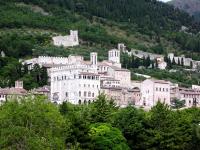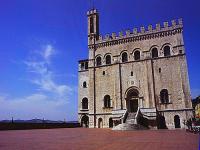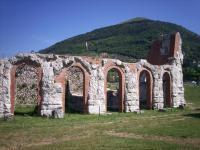Clinging to the steep slopes of the Monte Ingino, Gubbio appears an imposing and aloof city. Its Gothic stone buildings rise up the windy hillside and the waters of the Camignano gorge run down through its centre. The surrounding countryside is breathtaking as the town sits between unspoilt pastureland and the wooded Apennine mountains.
Gubbio was founded by the ancient Umbrii people around 300 BC and in Roman times it flourished as Iguvium, a key stopping point on the Via Flaminia. Two of the most important sights bear witness to this ancient history. The first is the bronze Eugubine Tablets which were discovered in 1444 close to the Roman theatre and date back to 200 BC. They are the most significant record of the Umbrian language, being partly written in the Etruscan alphabet and partly in the Latin. The text comprises an ancient prayer, codes of religious practice and a list of the city’s enemies of the time. Today they are housed in Museo Civico in the Palazzo dei Consoli in the main square. The second is the remains of the Roman Amphitheatre on the west side of the town, which is still used in the summer for performances of classical Greek and Roman drama.



In 1387 Gubbio fell under the control of the powerful Dukes of Montefeltro from the city of Urbino in today’s Le Marche region but then, in 1624, it became part of the Papal States. In this era, the city developed its own artistic school and the Pinacoteca (also housed in the Palazzo dei Consoli) displays works by local artists. At the same time a strong ceramic industry developed, which is still evident today in the beautifully hand-painted floral pottery and plates for sale around the town.
In the second world war Gubbio saw some fierce fighting between the occupying Germans and the partisans based in the mountains above and many innocent civilians were victims of the battle for Gubbio. The Piazza Quaranta Martiri on the west side of town is named after 40 citizens shot by Nazi soldiers.
As well as the Duomo and many churches in the centre of town, perhaps the most interesting to visit is the Basilica di Sant’ Ubaldo, named after the town’s patron saint, not least for the exciting journey up there. You can choose between a zig-zag path up the mountain or travel by funicular just outside the Porta Romana which takes about 5 minutes in a ski-lift type cage.
One of the most famous visitors to Gubbio was Saint Francis of Assisi who, in 1206, came to city to find it beseiged by wolves. Legend has it that the Saint spoke to the pack leader and made an agreement that it would stop terrorising the locals in return for regular meals. The deal was sealed with the shake of a paw and the wolf was later immortalised in a bas relief over the door of the church on Via Mastro Giorgio.
Hedonistic Hikers on our Medieval Umbria tour will have three days to explore this historic gem. Pictures show the town of Gubbio, the Palazzo dei Consoli, the Roman Amphitheatre, the Bronze Eugubine Tablets, the funicular up to Sant’Ubaldo and Saint Francis with the Wolf.
